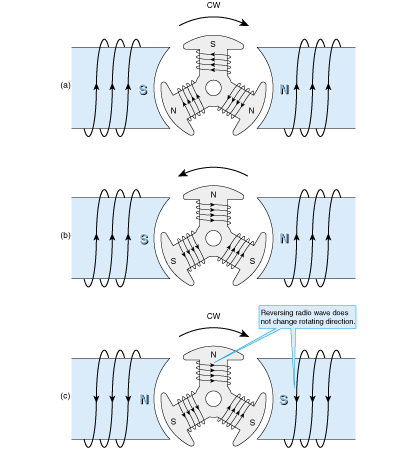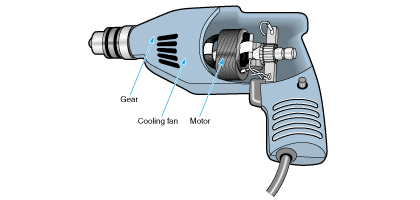2-3-1. Structure and Characteristics of AC Commutator Motors

series motor
(CW = Clockwise)
In Chapter 1, you have read about electromagnet-based DC motors. You have seen various connection methods there such as shunt, series, and separate field. Among these motors, what do you think will happen if AC power is applied to a series motor?
Assume that when the motor is rotating in the condition shown in Fig. 2.33 (a), the polarity of the voltage applied to the motor is reversed. If the polarity of the electromagnet remains the same as shown in Fig. 2.33 (b), then the current flowing through the rotor is reversed and, as a result, rotational direction of the rotor is reversed.
However, with a series motor, the polarity of the electromagnet is also reversed as shown in Fig. 2.33 (c). So the rotation direction remains unchanged.
Namely, this motor has a feature of being capable of continuing the rotation with AC power, too.
However, if you apply AC power to a series motor designed to be used with DC power, there occurs a problem. If AC power is applied when cast metal or soft steel is used for the stator core, current is generated due to electromagnetic induction (this current is called eddy current), generating a large amount of heat. Therefore, just like with an induction motor, a silicon steel-based insulation lamination structure is employed in the core of a commutator motor that operates on AC.
These motors are called universal motors since they are operable both on AC and DC.
However, since these motors are mostly operated on AC in practical use, they are called AC commutator motors.
Features and Disadvantages

AC commutator motors have the following features:
- ・Operable with 100 VAC for home use
- ・Rotate faster than induction motors
- ・Rotating speed goes down and torque increases under increased load
- ・Startup torque is large
Because of these characteristics, they are used for home appliances such as electric vacuum cleaners and tools such as electric drills (Fig. 2.34) that require high-output, lightweight motors, and mixers and coffee mills that need rotations faster than induction motors.
On the other hand, AC commutator motors have the following disadvantages:
- ・Generate noises
- ・Not suited for constant or continuous operation because of service life of the brushes


Is there a shunt AC commutator motor?
A series commutator motor is operable on AC. Then, is a shunt motor usable with AC?
When an electromagnet is used for generating fields, the inductance of the field coil becomes larger than that of the armature. If AC is applied to this field coil, its phase of current is lagged behind that of the armature. Thus, the magnetic flux density becomes low when the current is conducted to the armature, and when it becomes high, the current to the armature is stopped. In this case, sufficient motor torque is not available.
Compared to this, such a phenomenon does not occur on the series coil since its field coil and armature coil are in series and the phase of current of the both is identical. That is why the series structure is employed for AC commutator motors.